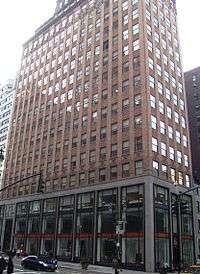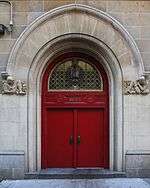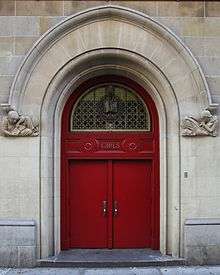Murray Hill, Manhattan
Coordinates: 40°44′54″N 73°58′42″W / 40.74833°N 73.97833°W

Murray Hill is a neighborhood in midtown Manhattan in New York City. In 1999, Manhattan Community Board 6 – of which Murray Hill is part – defined the boundaries as East 34th Street to the south, East 40th Street to the north, Madison Avenue to the west, and East River to the east.[1]
History
Eighteenth century
Murray Hill derives its name from the Murray family, 18th-century Quaker merchants mainly concerned with shipping and overseas trade. Robert Murray (1721–1786), the family patriarch, was born in County Armagh, Ireland, immigrated to Pennsylvania in 1732, and came to New York City in 1753 after a short residence in North Carolina. He quickly established himself as a merchant and eventually owned more shipping tonnage than any other New Yorker. About 1762 Murray rented land from the city for a great house and farm. His great house, which he named Inclenberg (or Belmont), but which was popularly termed Murray Hill, was built on a since-leveled hill at what is today Park Avenue and 36th Street. The great square house was approached by an avenue of mixed trees leading from the Boston Post Road;[2] it was surrounded on three sides with verandas—or “piazzas” as they were called in New York—and commanded views of the East River over Kips Bay. The total area was just over 29 acres (120,000 m2). In today’s terms, the farm began a few feet (meters) south of 33rd Street and extended north to the middle of the block between 38th and 39th Streets. At the southern end, the plot was rather narrow, but at the northern end it extended from approximately Lexington Avenue to a spot between Madison and Fifth Avenues.[3]
The Inclenberg was an abrupt, steep-sided mound of glacial till typical of Manhattan Island's still-unmodified post-glacial terrain: this "hill of the rudest and most heterogeneous mixture of stone and gravel and boulders, cemented together into a matrix of almost impenetrable density existed, crowning the underlying schist... It had a natural rise from 34th Street, sinking towards 42nd Street and reaching from Lexington Avenue to Broadway."[4] Such a soil would have been unpromising had Murray intended seriously to farm it; instead the house, like the other grand expressions of preeminent urban social position that crowned most of Manhattan's prominent rises of ground[5] had other uses: "although some of these estates grew crops for profit," the historians of New York Edwin G. Burrows and Mike Wallace observe,[6] "their primary purpose—besides providing refuge from epidemics—was to serve as theaters of refinement".
Mary Lindley Murray is credited with delaying William Howe and his army during General Washington's retreat from New York following the British landing at Kip's Bay, 15 September 1776. As the story goes, Mrs. Robert Murray, the mother of Lindley and John, invited the officers to tea[7] at her mansion of Inclenberg and, through feminine wiles, succeeded in delaying the British troops for a period sufficient to allow a successful American retreat.[1][8] She is said by Rev. T. Dewitt Talmage to have saved American independence by detaining Lord Howe long enough to permit Israel Putnam to pass up the Greenwich road from the city and join the forces of George Washington in the north end of the island, before Howe was able to overtake him. This detention and the stories told by the fair friend saved 4,000 men, who otherwise would have been cut off and captured.
James Thacher, M.D., a gossipy surgeon with the Continental Army, kept a journal that is one of the prime sources of information about the military happenings of the times. In an entry for Sept. 20, Thacher tells the story as follows: "The British generals...repaired to the house of a Mr. Robert Murray, a Quaker and friend of our cause; Mrs. Murray treated them with cake and wine, and they were induced to tarry two hours or more, Governor Tryon frequently joking her about her American friends. By this happy incident general Putnam, by continuing his march, escaped...It has since become almost a common saying among our officers, that Mrs. Murray saved this part of the American army."[9]
The most illustrious member of the family was the oldest child, Lindley Murray (1745–1826). A New York lawyer, he was forced into exile after the Revolution as a loyalist. In England, Lindley wrote 11 school textbooks which had their greatest success in the new United States, partly because no international copyright existed and the books could be reprinted without royalties. Some 16 million copies of Murray's books were sold in America. His English Reader utterly dominated the American market for readers from 1815 into the 1840s.
Nineteenth century
.jpg)
During the 19th century, this neighborhood was "uptown" with the city ending with the reservoir at Fifth Avenue and 42nd Street covering what today is the New York Public Library and Bryant Park. To the north was for the most part farmland. In the bitter winter of 1808 during the embargo that closed New York harbor, an innovative work relief program kept out-of-work dock workers busy reducing the height of Murray Hill;[10] between twenty and forty feet were sliced off its summit and used for fill.[11] In 1833 the railroad cut was begun, to carry the New York and Harlem Rail Road through Murray Hill; the route under the most prominent obstacle in its right-of-way was opened 1 May 1834;[12] then the locomotives, which had met the horse-cars that ran through the city's streets at the station at 27th Street, could pass the reduced hill; by an act of 1850 the city pemitted to roof over the cut for the passage of steam locomotives. This Park Avenue Tunnel, enlarged and relined, has been devoted to automobile traffic since 1937.[13]
In mid-century, the rich temporarily, and the upper middle class more permanently, filled the brownstone row houses that filled Murray Hill's streets. The Brick Presbyterian Church followed its congregation; after selling its site facing City Hall Park, it rebuilt in 1857 closer to its congregation, on the smoothed brow of Murray Hill, at Fifth Avenue and 37th Street.[14] However, when J. P. Morgan built his conservative brownstone free-standing mansion in 1882 on Madison Avenue at 36th Street, which is today a part of The Morgan Library & Museum, it was considered a fashionable but slightly old-fashioned address,[15] as the rich were filling Fifth Avenue with palaces as far as Central Park. Instead stylish merchandising was changing the neighborhood; Madison Square Park, at this time considered a part of Murray Hill, was bordered by the fashionable ladies' shops of the day on Fifth Avenue.
Late twentieth century
For much of the 20th century, the neighborhood was a quiet and rather formal place, with many wealthy older residents. In 1905, Franklin and Eleanor Roosevelt lived close by Franklin's mother Sara Roosevelt in the Murray Hill neighborhood.[16]
Since the late 1990s, many young people in their twenties have moved to the area from the suburbs of New York. As reported in the New York Times in 2011, "...recent college graduates can find themselves among fellow alumni, meet up for familiar drinking rituals and flock to the frozen-yogurt shops and sushi bars that help them stay fit and find a mate for the next stage of life".[17] On weekends, the raucous restaurant-and-bar scene along Third Avenue, beyond the traditional eastern limits of Murray Hill, particularly reflects this change. In the late 1990s, Murray Hill began to attract an influx of young college graduates, leading to a "work-hard, play-hard" atmosphere, which has since been referenced in several media sources such as The New York Times[17] and New York Post. Though housing in the neighborhood is slightly cheaper than in fashionable nearby parts of Manhattan, prices for apartments here rose a great deal during the boom of the late 1990s and early 2000s—as much as 500 percent in a decade.
Structures

The community is home to the CUNY Graduate Center which share the landmark former B. Altman Building with the New York Public Library's Science, Industry and Business Library (SIBL) and with Oxford University Press. The neighborhood is also home to Stern College for Women of Yeshiva University, The Morgan Library & Museum, Scandinavia House–The Nordic Center in America, The Mexican Cultural Institute of New York, and a historically notable private institution, the Union League Club of New York. The area also includes 10 East 40th Street, an example of art deco architecture.
On January 29, 2008, the Whitney Museum of American Art branch gallery at what had been the Philip Morris headquarters opposite Grand Central Terminal closed after a 25-year run. For around fifty years the neighborhood has been home to the National Review, the conservative journal of opinion founded by William F. Buckley, Jr., most of that time at 150 East 35th Street, currently at 215 Lexington Avenue at 33rd Street. 150 East 35th Street was purchased by Yeshiva University.
Economy
L-3 Communications has its headquarters in Murray Hill.[18] Sumitomo Corporation operates its New York Office, the headquarters of the corporation's United States operations, in the same building as the headquarters of L-3. Industries supported by the office include Aerospace and Defense, Agricultural Commodities, Agrochemicals, Business Investment, Chemicals, Fertilizer, Information Technology, Latin American Operations, Living Related Products, Media and IT Venture Group, Meat Products, Presidio Venture Partners, Ship, Real Estate, Transportation Systems and Equipment, and Tubular Products.[19] China Airlines operates its New York Branch Office in Suite 800 at 633 3rd Avenue (10017).[20][21]
In 1975 American Airlines was headquartered at 633 Third Avenue.[22] In 1978 American announced that it would move its headquarters to a site at Dallas/Fort Worth International Airport in 1979. The move affected up to 1,300 jobs. Mayor of New York City Ed Koch described this move as "betrayal" of New York City.[23]
Diplomatic missions

Due to the proximity of the headquarters of the United Nations and the availability of old mansions, many countries operate embassies and consulates in Murray Hill, including:
- The Consulate-General of Mexico in New York, at 27 East 39th Street (10016).[24]
- The Consulate-General of South Africa in New York, at 333 East 38th Street (10016).[25]
- The Consulate-General of the Republic of Poland at 233 Madison Ave (10016).
Missions to the United Nations in Murray Hill include:[26]
Education


The New York City Department of Education operates local public schools. P.S. 116, Mary Lindley Murray School, is the neighborhood elementary school.[1][28] The entrances to P.S. 116 on 33rd Street are segregated into "Boys'" and "Girls'" doors. Each entrance features decorative carvings of male and female students, respectively, engaged in reading and scientific activities.
Murray Hill residents are also zoned to I.S. 104, the Simon Baruch School, located in the Gramercy Park neighborhood.[29]
Telephone exchange
For the most part of the 20th century the name "Murray Hill" was used by New York Telephone as a telephone exchange for residents living on the East Side of Manhattan, served from the East 37th Street exchange building. Most neighborhoods at the time would be grouped together by a particular exchange name. Other municipalities in the United States would also use MUrray or MUrray Hill as an exchange name. The first two letters in MUrray (capitalized to indicate that they should be dialed) would be joined by five number digits to make up a telephone number such as MUrray Hill 5-9975 (the Ricardos' number on I Love Lucy). This was the way most telephone numbers were given until AT&T switched to All-Number Calling by the late 1970s to early 1980s. Nevertheless, the name MUrray Hill is still applicable, as many East Side phone numbers still begin with 68, which corresponds to MU on the telephone keypad.
See also
- Robert Murray (merchant) (1721–1786)
- Lindley Murray (1745–1826)
References
Notes
- 1 2 3 Cheslow, Jerry (December 5, 1999). "If You're Thinking of Living In / Murray Hill; A Quiet Enclave Close to Midtown". The New York Times. Retrieved January 12, 2008.
- ↑ Shown on a detail of the British Headquarters map, c. 1781 in Eric W. Sanderson, Mannahatta: A Natural History of New York City, 2009:55, fig. a. The orchards are shown behind the house to the north.
- ↑ Muschamp, Herbert (December 5, 1997). "Critic's Notebook; Atop a Hill In Midtown, Where Life Is a Stroll". The New York Times. Retrieved July 1, 2008.
- ↑ L.P. Gratacap, Geology of the City of New York (New York, 1904), quoted in Sanderson 2009: appendix A p. 252.
- ↑ See, for some examples, articles for Richmond Hill, the Apthorp Farm, the Morris-Jumel Mansion, Gracie Mansion, and Alexander Hamilton's "Grange"
- ↑ Burrows and Wallace 1999:179.
- ↑ Plying them with cakes and wine in earlier tellings, as reported in Edwin G. Burrows and Mike Wallace, Gotham: a History of New York City to 1898 1999:241.
- ↑ McCullough, David. "1776", p. 216. "In explanation, a romantic story spread - a story that would become legendary - that a Mrs. Robert Murray, a Quaker and an ardent patriot, had delayed William Howe and his generals by inviting them to afternoon tea at her country home at Inclenberg, later known as Murray Hill."
- ↑ Thacher, James (1854). Military Journal, During the American Revolutionary War, from 1775 to 1783. Silas Andrus & Son. p. 494.
- ↑ Burrows and Wallace 1999:412.
- ↑ Sanderson 2008:map "Fill and Excavation, 1609-2009" p. 81,
- ↑ Joseph Brennan (Columbia University) "Abandoned Stations: 38 St."
- ↑ Brennan.
- ↑ Burrows and Wallace 1999:717
- ↑ "In the no longer cutting-edge Murray Hill" (Burrows and Wallace 1999:1075).
- ↑ placematters.net
- 1 2 Berger, Joseph (January 18, 2011). "In Murray Hill, the College Life Need Never End". The New York Times. Retrieved January 19, 2011.
- ↑ "Company Profile." L-3 Communications. Retrieved on March 10, 2010.
- ↑ "Office Network." Sumitomo Corporation. Retrieved on January 25, 2009.
- ↑ "Flatiron / Gramercy / Murray Hill / Union Square: Manhattan Neighborhood Map." About.com. Retrieved on January 25, 2009.
- ↑ "Branch Offices North America." China Airlines. Retrieved on January 25, 2009.
- ↑ World Airline Directory. Flight International. March 20, 1975. "472.
- ↑ Sterba, James P. "American Will Shift Headquarters From Manhattan to Dallas Airport; Big Economies Predicted." The New York Times. Thursday November 16, 1978. Page A1. Retrieved on August 27, 2009.
- ↑ Home Page." Consulate-General of Mexico in New York. Retrieved on January 25, 2009.
- ↑ Home Page." Consulate-General of South Africa in New York. Retrieved on January 26, 2009.
- ↑ "United Nations Member States." United Nations. Retrieved on January 26, 2009.
- ↑ Home page. Permanent Mission of the People's Republic of China to the United Nations. Retrieved on January 26, 2009.
- ↑ "P.S. 116 Mary Lindley Murray School." Insideschools.org. Retrieved on January 25, 2009.
- ↑ "School Search" New York City Department of Education. Retrieved on January 25, 2009
Further reading
- Gregor, Alison (August 13, 2014). "Murray Hill for Family Living". The New York Times. ISSN 0362-4331. Retrieved 2015-12-01.
- Lagorio, Christine (November 18, 2004). "Close-Up on Murray Hill". Village Voice. Retrieved 2006-01-27.
- Monaghan, Charles (May, 1996) "Lindley Murray and the Enlightenment" Paradigm
External links
| Wikimedia Commons has media related to Murray Hill, Manhattan. |
